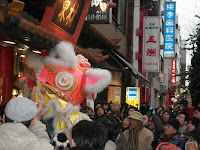



Lunar New Year’s events at Chinatown cheer up Yokohama
February is the hottest season of the year for residents of the Yokohama Chinatown, with various traditional events held for the lunar New Year’s holidays. Since the lunar New Year’s Day, “Chunjie” in Chinese, fell on Sunday this year, the town attracted more visitors than usual.
The Yokohama Chinatown, with an area of 0.2 square kilometer, accommodates more than 500 shops, including about 200 Chinese restaurants and over 50 ethnic food and souvenir shops.
Visitors and tourists flocked to the Chinatown Sunday aiming to take a look at lion dance performances, one of the most attractive events for the New Year’s period. “We divide into four groups. We’re gonna call at about 50 shops each today,” a performer said. Each group has a pair of dance performers holding the mask and body of the lion and four to five musicians. They perform lion dances on drum beats at the entrance of the shops praying for a success of their business for the New Year.
The Yokohama Chinatown, the largest in East Asia, is hemmed by 10 Chinese-style gates. The largest of them, the Goodwill Gate, stands at the busiest corner in the town. Every street in the area was filled with so many visitors that it was very hard for vehicles and shoppers to pass. Trying to maintain order among the crowd, a staffer shouted, “Don’t push, please. You don’t need to hurry. We have many more performances until evening.”
Yokohama, Japan’s second largest city, was a small fishing village until the middle of the 19th century, when it was turned into a port for commerce with other countries toward the end of the Edo period. The opening of the port triggered an inflow of many foreigners, including immigrants and merchants from China, who started their business at a quarter of the designated foreign settlement area. The community of ethnic Chinese, mainly from Guangzhou, was relatively small at the initial stage. The community underwent turbulent years as Japan and China fought two wars from the late 19th century to the 1940s, but it has grown into one of the biggest tourist spots in Yokohama.
The year 2009 was the 150th anniversary of the opening of the port at Yokohama. The city held a big exposition at a portside area in commemoration of the anniversary from April to September last year, but the number of visitors to the event fell far short of the target of five million. The disappointing result was attributed mainly to an allegedly inappropriate project concept, but it also reflected weak consumer sentiment amid Japan’s economic slump. The series of New Year’s events at the Yokohama Chinatown has helped dispel the bearish economic mood and spirit up people's mind.
Visitors and tourists flocked to the Chinatown Sunday aiming to take a look at lion dance performances, one of the most attractive events for the New Year’s period. “We divide into four groups. We’re gonna call at about 50 shops each today,” a performer said. Each group has a pair of dance performers holding the mask and body of the lion and four to five musicians. They perform lion dances on drum beats at the entrance of the shops praying for a success of their business for the New Year.
The Yokohama Chinatown, the largest in East Asia, is hemmed by 10 Chinese-style gates. The largest of them, the Goodwill Gate, stands at the busiest corner in the town. Every street in the area was filled with so many visitors that it was very hard for vehicles and shoppers to pass. Trying to maintain order among the crowd, a staffer shouted, “Don’t push, please. You don’t need to hurry. We have many more performances until evening.”
Yokohama, Japan’s second largest city, was a small fishing village until the middle of the 19th century, when it was turned into a port for commerce with other countries toward the end of the Edo period. The opening of the port triggered an inflow of many foreigners, including immigrants and merchants from China, who started their business at a quarter of the designated foreign settlement area. The community of ethnic Chinese, mainly from Guangzhou, was relatively small at the initial stage. The community underwent turbulent years as Japan and China fought two wars from the late 19th century to the 1940s, but it has grown into one of the biggest tourist spots in Yokohama.
The year 2009 was the 150th anniversary of the opening of the port at Yokohama. The city held a big exposition at a portside area in commemoration of the anniversary from April to September last year, but the number of visitors to the event fell far short of the target of five million. The disappointing result was attributed mainly to an allegedly inappropriate project concept, but it also reflected weak consumer sentiment amid Japan’s economic slump. The series of New Year’s events at the Yokohama Chinatown has helped dispel the bearish economic mood and spirit up people's mind.

No comments:
Post a Comment